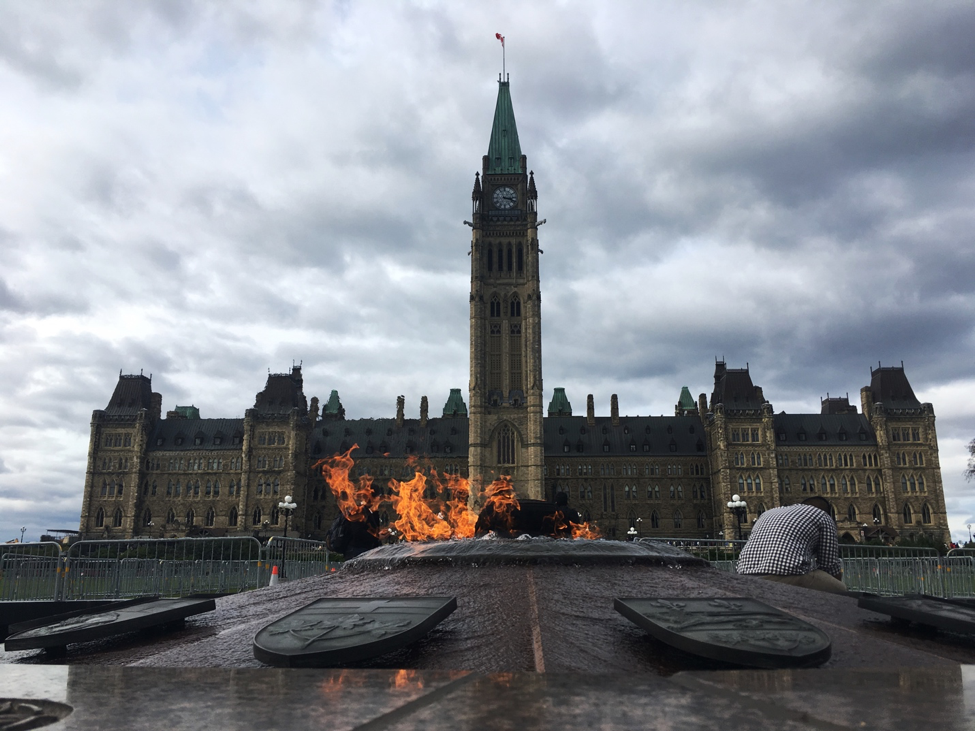Centennial Flame to be inscribed with official symbols of Nunavut
By Irene Galea
For its 50th birthday, the Centennial Flame is getting a $900,000 gift of national importance: the cementing of national unity in the form of a new, shiny bronze coat of arms.
Officials from the Department of Canadian Heritage announced on Sept. 25 that the flaming monument on Parliament Hill will finally be inscribed with the official symbols of Nunavut, with the remodelling to be completed and officially unveiled in December.
The 12-sided fountain, which currently displays the coats of arms and territorial flowers of each of the 10 provinces and two territories that existed when it was built in 1967, will be deconstructed and altered to allow for a 13th panel. The monument’s wedges are to be either carved down or augmented in order to accommodate the new segment.
The Centennial Flame was constructed 50 years ago in honour of a century of Canadian Confederation. Nunavut became Canada’s newest territory when it was created from the eastern portion the Northwest Territories in 1999.
Now, Nunavut’s place in Confederation is being set in stone.

Heritage Minister Mélanie Joly said the addition to the fountain is a fitting way to mark Canada’s 150 birthday in 2017.
“This beautiful territory may be the newest addition to Confederation,” she said, “but its history and heritage run deep in our identity.”
Canadian Heritage is overseeing the project, but the funding and execution of the reconstruction falls under Public Services and Procurement Canada. According to Katherine Cyr, a spokesperson with Canadian Heritage, the estimated cost will be about $900,000.
The amount represents a tiny percentage of the $3-billion budget set for the entire rehabilitation of Parliament Hill, which began in 2011 and includes major upgrades to Centre Block and other buildings, a new visitors’ centre and the modernization of security and infrastructure.
But based on an average of about $5,000 in coins tossed into the fountain every year, it would take even more than the next 150 years of Confederation for the Centennial Flame to pay for its own reconstruction.
Susan Ross, a Carleton University professor of Indigenous and Canadian Studies and an expert in sustainable heritage conservation, said the remodelling to embrace Nunavut is important.
“Heritage is not just about preserving things as they are,” she said. “Things need to be adapted. Just look at how much change they’re doing on the Hill.”
The decade-long rehabilitation of Centre Block, which is said to be PSPC’s largest and most complex project to date, is set to begin in 2018, and will include restoration of stone masonry, windows, stained glass, structural integrity and roofing.
When it comes to rejuvenating Canadian heritage sites, said Ross, “it’s about balancing the historic values, character and design with what needs to change.”
Hilu Tagoona, an Inuk from Nunavut who is attending Carleton University, agreed that the change to the Centennial Flame is necessary. She said she feels it’s important that her home is recognized on a monument meant to represent the entire country.
“In all hindsight, we would have loved to have seen it sooner, considering the paperwork [for the creation of Nunavut] was signed in 1993,” she said. “It’s not something brand new. But it is exciting that it will finally be added.”
Tagoona said she hopes to attend the unveiling with her family in December.
“We’re all very proud to be Inuit, and we’re proud to be a part of Canada.”
The shield of Nunavut is round and features an inukshuk, qulliq (an Inuit stone lamp), five gold circles representing the arc of the sun, and the North Star. The official territorial flower is purple saxifrage, which represents the resilience and perseverance of the territory.
“Nunavut plays an important role in protecting the sovereignty and security of Confederation,” said George Qulaut, speaker of the Legislative Assembly of Nunavut, in a press release issued following Joly’s announcement.
“We look forward to having our symbols included on the Centennial Flame, ensuring that this special landmark honours all jurisdictions in Canada today.”

